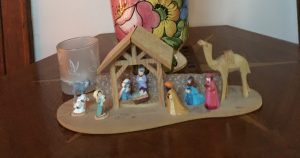It’s Christmas. The time of year when Christians celebrate the arrival of God on earth in the person of a tiny baby. Odd, isn’t it, how this incredible (read: unbelievable) story has been elaborated: Angel announcements. Miraculous star. Amazed shepherds. Kings with gifts. These and other colorful details dress up the festivities we Christians play out year after year. The Nativity Story collects several different versions of what may or may not have actually happened into one seamless pageant. It brings to children, and to childlike hearts, a sense of wonder and joy.
These and other colorful details dress up the festivities we Christians play out year after year. The Nativity Story collects several different versions of what may or may not have actually happened into one seamless pageant. It brings to children, and to childlike hearts, a sense of wonder and joy.
Meanwhile, it stirs up a great deal of controversy, among Christians and non-Christians, too. God coming to earth in person—in a person?
Christian scriptures tell us: “God is Spirit, and those who worship him must worship him in spirit and in truth.” As one hymn puts it, “Immortal, invisible God only wise, in light inaccessible, hid from our eyes.”
God is not a person. What is this thing about Christmas?
In the beginning, something (call it Spirit) prevailed over nothing and everything began to take on substance. Sound and hearing, light and eyes, breath and life. One wouldn’t exist without the other, right? The universe was made for people, and people for the universe.
Furthermore, as the story goes, “In His own image, created he them, man and woman.”
Wait! In his own image? What image?
Conventional pronoun aside, God doesn’t have eyes, ears, hands, or feet, or any other physical qualities. God isn’t a body, doesn’t have a body.
But how could people comprehend the Spirit God except through our senses and our stories? How could we get past the limitation of our bodies?
To my way of thinking, Christianity is a kind of reverse engineering.
Jesus, born human, is the consummate expression of who and how we were created to be as human beings in the image of the image-less God. We, like Jesus, are creatures of both body and Spirit. Associating ourselves with Jesus in the sacramental framework of religion is a pretty good way to discover and appreciate the wonders of our universe and the meaning of our lives within it. Human beings as spirit are connected to each other as a single body is connected, to protect, enable, activate (feed, clothe, heal, educate) every member of our being.
As another hymn affirms, “We are one in the Spirit, we are one in the Lord…and we pray that our unity may someday be restored….They will know we are Christians by our love….”
Children, it’s that simple. May it be so.







Thank you, Barbara.
Merry Christmas throughout the coming year.
I’ve often thought about this. It’s natural to imagine that God looks like a gigantic version of ourselves. (Even the Hebrews, who were not allowed to make images of their God, obviously saw him as one of those deities who wear city walls as a crown). My cats, if they have religion, probably see God as an all-powerful cat.
For all we know, God would actually look like an enormous, star-entangled sea anemone.
But I hope not. Looking like Jesus is better.
Sometimes when I look for Jesus, I just see Martha and Barbara and Paul and Marcia and Kite and David and Kristie and. . .and then I get it.
Beautifully written, Barb.